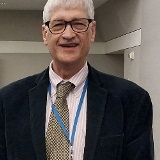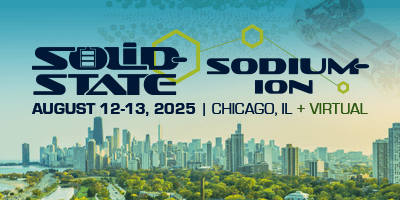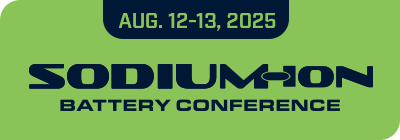Sodium-ion Battery Conference
나트륨 이온 배터리 : 지속가능성과 효율성을 중시한 에너지 저장을 추진
2025년 8월 12일 - 13일 CDT(미국 중부 표준시·서머타임)
Tuesday, August 12
7:00 amRegistration and Morning Coffee
8:20 amVictoria Mosolgo, Conference Producer, Cambridge Enertech
CHARACTERIZATION AND PERFORMANCE IN SODIUM-ION BATTERY MATERIALS
Characterization of Performance and Safety of Commercial Sodium-ion Batteries
 Dhevathi R. Rajagopalan Kannan, PhD, Research Scientist, Electrochemical Safety Research Institute, UL Research Institutes
Dhevathi R. Rajagopalan Kannan, PhD, Research Scientist, Electrochemical Safety Research Institute, UL Research Institutes
Sodium-ion batteries have seen increased interest in recent years as an alternative to lithium-ion batteries. However, there have been limited studies that examine their performance and safety characteristics. This study focuses on the characterization of the cycle life performance and safety aspects of commercial sodium-ion cells. Results of safety tests including overcharge, overdischarge, and external short tests, both at the cell and module-level, will be discussed. Information derived from the destructive physical analysis of cells will also be included. Insights gained from this research program will aid in the development of safer and more reliable sodium-ion based energy storage systems.
Molecular-Level Precursor Control Strategy Enhances Fast-Charging Hard Carbon Anodes for Sodium-ion Batteries
Shulei Chou, PhD, Professor, Chemistry, Wenzhou University
This study presents a microwave-assisted synergistic acid treatment to modify natural lotus peduncle-derived hard carbon for sodium-ion batteries (SIBs). The method improves structural regulation, enhancing rate capability and cycling stability, achieving a capacity of 354.8 mAh g-1 at 20 mA g-1.
Hard Carbons
 Nuria Tapia Ruiz, PhD, Senior Lecturer, Department of Chemistry, Imperial College London
Nuria Tapia Ruiz, PhD, Senior Lecturer, Department of Chemistry, Imperial College London
Hard carbon is a promising negative electrode material for sodium-ion batteries due to the ready availability of their precursors and high reversible charge storage. The reaction mechanisms that drive the sodiation properties in HC and subsequent electrochemical performance are strictly linked to the characteristic slope and plateau regions observed. The talk will focus on the use of electron paramagnetic resonance to gain further mechanistic insights into HCs.
10:00 amGrand Opening Coffee Break in the Exhibit Hall with Poster Viewing (Sponsor Opportunity Available)
SODIUM-ION BATTERY PERFORMANCE AND STABILITY
Na-Battery Lifecycle
 Bruce S. Dunn, PhD, Distinguished Professor of Materials Science and Engineering, Nippon Sheet Glass Chair, University of California Los Angeles
Bruce S. Dunn, PhD, Distinguished Professor of Materials Science and Engineering, Nippon Sheet Glass Chair, University of California Los Angeles
The increased interest in sodium-ion batteries has led to an active effort in identifying a new generation of electrode materials. In particular, pseudocapacitive materials have attracted considerable attention because of the prospect of achieving high energy density at high rates of charge and discharge. This presentation reviews our recent findings involving crystalline and amorphous TiO2 and VO2 and their function as anodes and cathodes for sodium-ion batteries.
Cycling Stability of Sodium-ion Batteries
Anji Reddy Munnangi, PhD, Senior Lecturer, Electrochemical Energy Storage, Swansea University
This study synthesizes polycrystalline and single-crystal P2-type Na0.67-δMn0.67Ni0.33O2 cathodes for sodium-ion batteries. The single-crystal cathode demonstrates significantly better cycling stability, achieving 47% higher capacity retention after 175 cycles, due to reduced parasitic side reactions.
11:45 amSponsored Presentation (Opportunity Available)
12:15 pmEnjoy Lunch on Your Own
HIGH-POWER AND INDUSTRIAL APPLICATIONS
Sodium-Based Batteries for Gigawatt-Scale Energy Storage: Opportunities and Challenges
 Guosheng Li, PhD, Senior Scientist, Battery Chemistry & Electrochemistry Group, Pacific Northwest National Laboratory
Guosheng Li, PhD, Senior Scientist, Battery Chemistry & Electrochemistry Group, Pacific Northwest National Laboratory
With sodium (Na) being more abundant and affordable than lithium, Na-based batteries are emerging as a strong alternative to lithium-ion batteries (LIBs) for large-scale storage. They offer lower material costs and a more stable supply chain, making them ideal for gigawatt-scale grid applications where cost per kilowatt-hour (kWh) is a critical factor.
2:45 pmSponsored Presentation (Opportunity Available)
3:15 pmRefreshment Break in the Exhibit Hall with Poster Viewing (Sponsorship Opportunity Available)
SODIUM-ION SCALE UP
Scaling Sodium-ion: From Laboratory Innovation to Commercial Deployment
Asmae El Mejdoubi, PhD, Chief Product Officer, Product Department, Tiamat SAS
- Bridging the Gap between R&D and Manufacturing: What are the biggest hurdles in scaling up SIB production?
- Standardization & Supply Chain Readiness: Are there enough raw material and supply chain structures in place to support mass adoption?
- Competing with Established Technologies: Where can SIBs carve out a strong foothold alongside or against lithium-based batteries?
4:45 pmNetworking Reception in the Exhibit Hall with Poster Viewing (Sponsor Opportunity Available)
5:45 pmClose of Day
5:45 pmConference Tutorials*
Please click here for tutorial descriptions: Tutorials *Separate registration required
Wednesday, August 13
7:30 amRegistration and Morning Coffee
NOVEL ELECTRODE MATERIALS AND CHEMISTRIES
Electrodes in Sodium Batteries
Shinichi Komaba, PhD, Professor, Applied Chemistry, Tokyo University of Science
This study improves the cycling stability of P′2-Na2/3MnO2, a promising Na-ion battery cathode, by doping with Sc3+ ions. The doping reduces capacity decay without sacrificing performance, helping maintain crystallinity and structure during cycling, enhancing battery lifespan.
Development of Earth-Abundant Mn-Rich Positive Electrode Materials for Sodium-ion Batteries
 Hui Claire Xiong, PhD, Associate Professor, Materials Science & Engineering, Boise State University
Hui Claire Xiong, PhD, Associate Professor, Materials Science & Engineering, Boise State University
Sodium-ion batteries (SIBs) are considered as an appealing candidate owing to the abundance and low cost of raw materials. In this talk, I will introduce our recent work at the Electrochemical Energy Materials Laboratory (EEML) related to the development of earth-abundant Mn-rich layered oxide positive electrode materials for SIBs. We hope to provide some perspectives regarding the promises and challenges in developing these materials.
9:00 amSponsored Presentation (Opportunity Available)
9:30 amCoffee Break in the Exhibit Hall with Poster Viewing (Sponsorship Opportunity Available)
EMERGING ANODE, CATHODE, AND ELECTROLYTE TECHNOLOGIES
Delineating the Intricacies of Sodium-ion Battery Cathodes and Their Interfaces
 Arumugam Manthiram, PhD, Abell Endowed Chair, Engineering, University of Texas Austin
Arumugam Manthiram, PhD, Abell Endowed Chair, Engineering, University of Texas Austin
Sodium-ion batteries offer a significant cost and sustainability advantage compared to lithium-ion batteries, but they are hampered by severe challenges with cathodes, anodes, and electrolytes and the interfaces associated with them. This presentation will focus on the intricacies involved with layered oxide and Prussian blue analogue cathodes and design of cathode morphology and electrolytes to overcome the challenges. Use of advanced characterization methodologies, such as time-of-flight-secondary ion mass spectrometry, scanning electron microscopy, differential scanning calorimetry, and in-situ gas evolution measurements, to delineate the intricacies will be presented.
Anodes for Sodium-ion Batteries Based on Tin-Germanium-Antimony Alloys
 David Mitlin, PhD, David Allen Cockrell Professor in Engineering, University of Texas Austin
David Mitlin, PhD, David Allen Cockrell Professor in Engineering, University of Texas Austin
Sodium ion batteries (SIBs) and sodium metal batteries (SMBs) are promising options in next-generation energy storage technology. For anode-free SMBs (AF-SMBs), where the cathode is the only ion reservoir, the challenge is to achieve stable electrodeposition/dissolution onto an "empty" current collector, rather than onto pre-existing sodium metal. Despite recent advances, the heterogeneous nature of the reactive growing/shrinking metal - electrolyte interphase remains not fully understood. This study examines how current collector support chemistry (sodiophilic intermetallic Na2Te vs. sodiophobic baseline Cu) and electrodeposition rate affect microstructure of sodium metal and its solid electrolyte interphase (SEI). Capacity and current (6 mAh cm-2, 0.5-3 mA cm-2) representative of commercially relevant mass loading in anode-free sodium metal battery (AF-SMBs) are analyzed. Synchrotron X-ray nanotomography and grazing-incidence wide-angle X-ray scattering (GIWAXS) are combined with cryogenic focused ion beam (cryo-FIB) microscopy. Highlighted are major differences in film morphology, internal porosity, and crystallographic preferred orientation e.g. (110) vs. (100) and (211) with support and deposition rate. Within the SEI, sodium fluoride (NaF) is more prevalent with Te-Cu versus sodium hydride (NaH) and sodium hydroxide (NaOH) with baseline Cu. Due to competitive grain growth the preferred orientation of sodium crystallites depends on film thickness. Mesoscale modelling delineates the role of SEI (ionic conductivity, morphology) on electrodeposit growth and onset of electrochemical instability.
Nuclear Magnetic Resonance Investigations of Ion Transport In Sodium Electrolytes - An Update
 Steven G. Greenbaum, Professor, Physics & Astronomy, Hunter College, City University of New York
Steven G. Greenbaum, Professor, Physics & Astronomy, Hunter College, City University of New York
Sodium electrolyte development has borrowed largely from our collective experience in Li-based electrolytes regarding choice of solvents and salts (i.e. counterions). Nuclear magnetic resonance is a powerful method used by our group and others to characterize ion transport processes in lithium-based electrolytes. We present here some recent collaborative studies of Na-electrolytes, using 23Na and 19F NMR. In favorable cases, these measurements yield Na+ transference numbers and extent of ion pairing.
11:30 amEnjoy Lunch on Your Own
ADVANCED CHARACTERIZATION AND MECHANISMS
Advanced Characterization Techniques for in situ and operando Studies of Sodium-ion, Solid-State, and Other Energy Storage Devices in Action
 Zhenxing Feng, Associate Professor, Chemical Engineering, Oregon State University
Zhenxing Feng, Associate Professor, Chemical Engineering, Oregon State University
This talk explores advanced characterization techniques for in situ and operando studies of sodium-ion, solid-state, and other energy storage devices. It highlights methods that allow real-time observation of materials and reactions during operation, providing insights into performance, stability, and mechanisms at the atomic and molecular levels.
The Sodiation Mechanism in Sn/Hard Carbon Composite Anodes for Sodium-ion Batteries and the Importance of the Electrolyte
 Ivana Hasa, Associate Professor of Electrochemical Materials, University of Warwick (WMG)
Ivana Hasa, Associate Professor of Electrochemical Materials, University of Warwick (WMG)
This study examines Sn/Hard Carbon-based anodes for sodium-ion batteries (SIBs). While nanosized Sn suffers from instability due to severe volume expansion, micrometric Sn (µ-Sn) demonstrates enhanced stability, particularly in glyme-based electrolytes. Composite µ-Sn/HC electrodes exhibit enhanced stability and long cycle life due to the formation of a robust porous Sn network, which mitigates volume expansion and structural degradation, offering a promising pathway for high-performance SIB anodes.
THE ROAD AHEAD FOR SODIUM IONS: DEFINING A UNIQUE MARKET ROLE
How Can SiB Beat LFP in Future Applications from Technology, Market, Cost, and Sourcing Perspectives?
 Robert Stanek, Global Advisor, Business Strategy & Alternative Powertrains, P3 Automotive GmbH
Robert Stanek, Global Advisor, Business Strategy & Alternative Powertrains, P3 Automotive GmbH
We examine the technical gaps that still need to be addressed, particularly in energy density and cycle life, and evaluate the market conditions and cost structures that would enable SIBs to establish themselves in targeted segments such as stationary storage and entry-level mobility applications.
- Technology Benchmark position vs. LFP
- Cost Advantage and Supply Chain Implications
- Leading Market and Use Case Segments
2:30 pmRefreshment Break in the Exhibit Hall with Last Chance for Poster Viewing (Sponsorship Opportunity Available)
The Road ahead for Sodium-ion Batteries: Competing with LFP and Defining a Unique Market Role
Robert Stanek, Global Advisor, Business Strategy & Alternative Powertrains, P3 Automotive GmbH
- Key Technical Milestones: How can SIBs improve energy density and cycle life to match LFP’s reliability?
- Market Positioning: Which applications (stationary storage, entry-level mobility, or others) offer the most realistic adoption pathway for SIBs?
- Cost & Supply Chain Considerations: With lithium prices fluctuating, does SIB’s supply chain advantage still hold weight?
- Policy & Investment Outlook: What role do regulations and funding initiatives play in shaping SIB's future?
4:00 pmClose of Summit
* 주최측 사정에 따라 사전 예고없이 프로그램이 변경될 수 있습니다.










